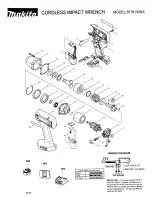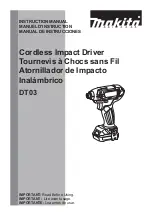
10
your risk from these exposures varies, depending upon
how often you do this type of work.
To reduce your exposure to these chemicals:
• Work in a well-ventilated area.
• Work with approved safety equipment, such as
dust masks that are specially designed to filter out
microscopic particles.
• Avoid prolonged contact with dust from power sanding,
sawing, grinding, drilling, and other construction
activities. Wear protective clothing and wash exposed
areas with soap and water.
Allowing dust to get into your mouth or eyes or to lie on
the skin may promote absorption of harmful chemicals.
work area safety
•
Keep work area clean and well lit.
Cluttered or dark areas
invite accidents. Rags, clothes, cords, strings and similar items
should never be left around the work area.
•
Do not operate power tools in explosive environments,
such as in the presence of flammable liquids, gases, or dust. Power
tools create sparks, which may ignite the dust or fumes.
•
Keep children and bystanders away while operating a
power tool.
Distractions can cause the operator to lose control.
Electrical safety
•
Power tool plugs must match the outlet.
Never modify the
plug in any way. Do not use any adaptor plugs with grounded power
tools. Unmodified plugs and matching outlets will reduce risk of
electric shock.
• Avoid body contact with grounded surfaces such
as pipes, radiators, ranges and refrigerators. There
is an increased risk of electric shock if your body is
grounded.
•
Do not expose power tools to rain or wet conditions.
Water entering a power tool will increase the risk of electric shock.
•
Do not abuse the cord. Never use the cord for carrying,
pulling or unplugging the power tool.
Keep the cord away
from heat, oil, sharp edges or moving parts. Replace damaged cords
immediately. Damaged or tangled cords increase the risk of electric
shock.
•
When operating a power tool outdoors, use an
extension cord suitable for outdoor use.
Use of a cord
suitable for outdoor use reduces the risk of electric shock.
•
If operating a power tool in a damp location is
unavoidable, use a residual current device (RCD)
or ground fault circuit interrupter (GFCI) protected
supply.
Use of an RCD or GFCI reduces the risk of electric shock.
Personal safety
•
Stay alert, watch what you are doing and use common
sense when operating a power tool.
DO NOT use a power
tool while you are tired or under the influence of drugs, alcohol or
medication. A moment of inattention while operating power tools
may result in serious personal injury.
•
Use personal protective equipment. Always wear eye
protection.
Protective equipment such as a dust mask, non-skid
safety shoes, a hard hat, or hearing protection will reduce personal
injuries.
•
Avoid accidental starting.
Ensure the switch is in the “off”
position before connecting to a power source and/or battery pack, or
picking up or carrying the tool. Carrying power tools with your finger
on the switch or plugging in power tools that have the switch “on”
invites accidents.
•
Remove any adjusting key or wrench before turning
the power tool on.
A wrench or key left attached to a rotating
part of the power tool may result in personal injury.
•
Do not overreach.
Keep proper footing and balance at all
times. This enables better control of the power tool in unexpected
situations.
•
Dress properly.
Do not wear loose clothing or jewellery. Always
wear eye and ear protection and use a dust mask. Keep your hair,
clothing and gloves away from moving parts. Loose clothes, jewelry
or long hair can be caught in moving parts.
•
If devices are used for dust extraction and collection,
ensure these devices are connected and used properly. Use of dust
collection devices can reduce dust-related hazards.
•
Do not use on a ladder or unstable support.
Stable
footing on a solid surface allows for better control of the power tool
in unexpected situations.
































